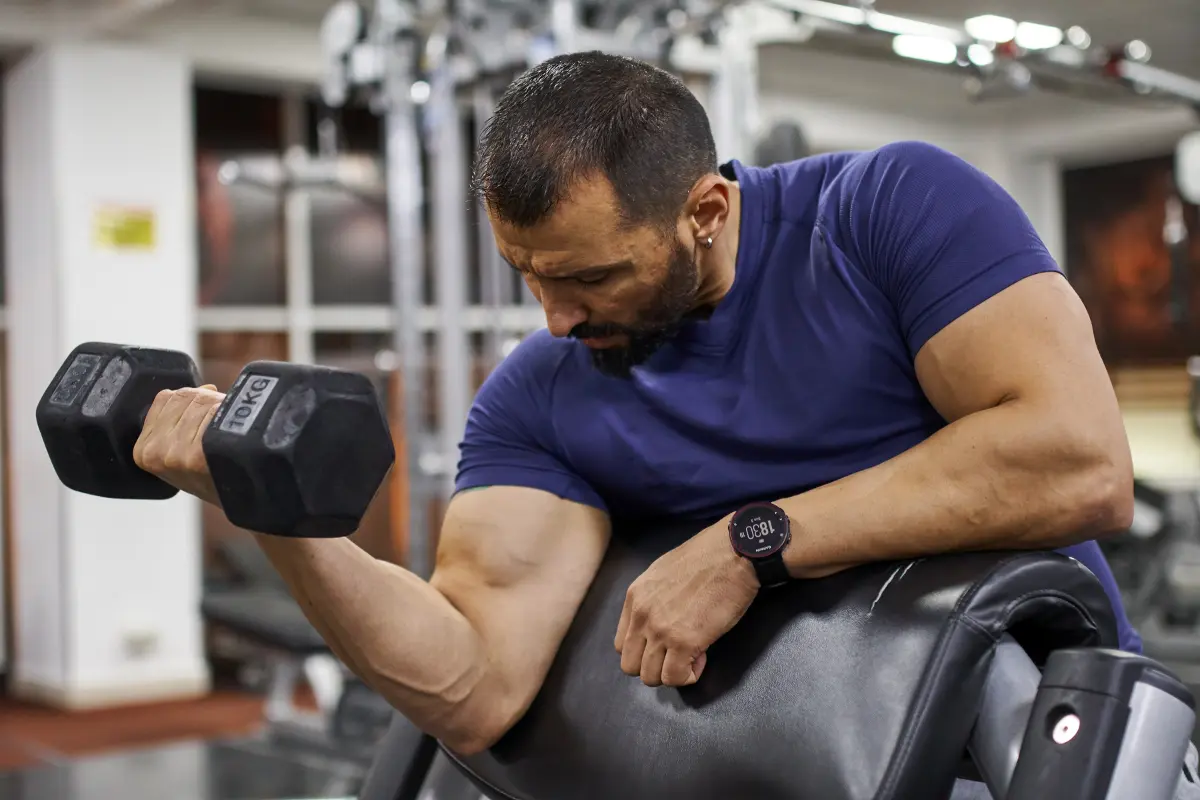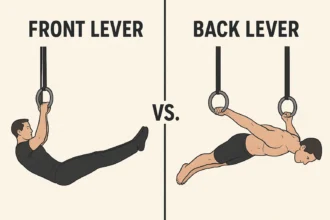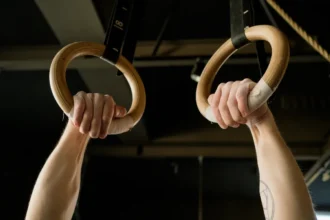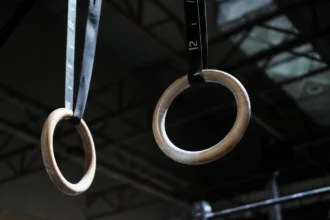Muscle imbalances are normal in human anatomy. It’s common to see slight differences in muscle shape and size between the left and right sides of the body. For instance, one bicep might have a different peak, or one lat may sit slightly lower than the other.
Why Do Biceps Become Uneven?
For most people, dominance plays a significant role. The arm you use more often (your dominant arm) tends to develop faster and become stronger due to the additional daily use. In contrast, your non-dominant arm gets less attention, which can lead to muscle imbalances over time.
However, neural input is another factor. Your brain is wired to engage the dominant side more efficiently, making it harder to activate the weaker side during exercises. This means that even though you may be training both arms equally, the weaker side is not activated as strongly, leading to uneven muscle development.
Now that you know why imbalances occur, let’s focus on how to fix them.
Improve Mind-Muscle Connection with Your Weaker Arm
One of the biggest reasons for muscle imbalances, including uneven biceps, is a weaker mind-muscle connection on the non-dominant side.
The stronger arm naturally recruits more muscle fibers during exercises, leading to better contractions and more growth. Meanwhile, the weaker arm may not engage as efficiently, causing it to lag behind. To improve this connection:
1) Actively Focus on Your Weaker Bicep During Workouts
When performing bicep exercises, mentally engage your weaker arm. Instead of just going through the motions, consciously think about your weaker bicep working during each rep. This can be done by saying “left side, left side” (if your left arm is weaker) in your head while curling. This small mental cue forces you to be more intentional with the movement and ensures your weaker side isn’t neglected.
2) Use Pre-Activation Techniques
Before starting your main exercises, wake up the weaker bicep with pre-activation work. This ensures the muscle is fully engaged before heavier compound movements. Here’s how:
- Isometric Holds: Flex and hold a bicep contraction on your weaker side for 10–15 seconds before starting your workout. This enhances neuromuscular activation.
- Unilateral Pre-Activation: Perform single-arm dumbbell curls or cable curls on the weaker arm before your main sets. This helps activate the muscle fibers that are often underused.
3) Slow Down Your Reps (Especially the Eccentric Phase)
Performing slow, controlled reps improve the connection between your brain and muscles. Instead of rushing through your curls, take 3–4 seconds to lower the weight (eccentric phase). This forces the muscle to stay under tension longer, increasing neural activation and overall engagement.
Incorporate Unilateral Exercises
To fix uneven biceps, unilateral exercises are a must. These are movements where you train one arm at a time, which helps ensure that each bicep is working equally and independently. This technique prevents the dominant, stronger arm from taking over and compensating for the weaker one, promoting balanced growth and strength development.
Why Unilateral Exercises Are Essential
In bilateral exercises (like barbell curls), your stronger arm tends to take on more of the load, which reinforces muscle imbalances. Unilateral exercises, on the other hand, force each arm to carry its own weight, ensuring that both biceps receive equal attention and workload, leading to more balanced muscle growth.
Examples of Unilateral Exercises for Biceps
Incorporating unilateral exercises into your routine is relatively simple, and several bicep-specific movements can help target and isolate the weaker side.
1. Dumbbell Bicep Curls
Performing curls with a dumbbell in each hand allows for independent movement, ensuring both biceps are engaged equally.
How to Perform Dumbbell Curls:
- Stand with a dumbbell in each hand, palms facing forward.
- Curl one dumbbell toward your shoulder while keeping your elbow stationary.
- Lower the dumbbell back down with control and repeat.
- Alternate arms or do all reps on one arm before switching.
Tip: Start with your weaker arm and match the number of reps on the stronger side, even if you could do more with your dominant arm.
2. Single-Arm Cable Bicep Curls
Cable curls are excellent for providing constant tension throughout the entire movement. By using a single cable, you can isolate the bicep on one arm at a time.
How to Perform Single-Arm Cable Curls:
- Attach a single handle to a low pulley and stand facing the machine.
- Grasp the handle with your weaker arm and curl it toward your shoulder, focusing on squeezing the bicep at the top.
- Slowly lower the handle back to the starting position and repeat.
- Switch arms after completing the set.
Tip: Use a slow, controlled motion to increase time under tension and maximize muscle engagement.
3. Single-Arm Preacher Curls
Utilizing a preacher bench, this exercise isolates the bicep by supporting the upper arm, allowing for a controlled curl with one arm at a time.
How to Perform Single-Arm Preacher Curls:
- Sit on a preacher bench and adjust the seat height to a comfortable position.
- Hold a dumbbell with your weaker hand and rest your upper arm on the pad.
- Curl the dumbbell toward your shoulder, focusing on squeezing the bicep at the top.
- Slowly lower the dumbbell back to the starting position and repeat.
Tip: Keep your upper arm pressed against the pad throughout the movement to maintain proper form.
4. Concentration Curls
This exercise involves curling a dumbbell with one arm while seated, focusing on squeezing the bicep at the top of the movement.
How to Perform Concentration Curls:
- Sit on a bench with your legs spread apart.
- Hold a dumbbell in your weaker hand and rest your elbow on the inside of your thigh.
- Curl the dumbbell toward your shoulder, focusing on squeezing the bicep at the top.
- Slowly lower the dumbbell back to the starting position and repeat.
Tip: Keep your upper arm stationary and avoid using momentum to lift the weight.
Focus on Equal Volume and Avoid Overcompensating
When working to correct uneven biceps, it’s crucial to focus on equal volume for both arms and avoid allowing your dominant arm to overcompensate. If your stronger bicep is doing more work than the weaker one, it will continue to grow disproportionately, and the muscle imbalance will persist.
Why Equal Volume Matters
Equal volume means that both your stronger and weaker arms are getting the same amount of work in terms of sets, reps, and load. Without equal attention, the weaker arm won’t have the chance to catch up in terms of size and strength. Additionally, if you let your dominant arm take over, it can create a “snowball effect” where your weaker arm continues to fall further behind, and the imbalance becomes harder to fix.
How to Avoid Overcompensating
Use Dumbbells and Cables: Dumbbells and cables are particularly helpful in ensuring that both arms are carrying an equal load. With dumbbells, your dominant arm can’t “cheat” by lifting more than its fair share because each arm is responsible for its weight. Similarly, cable machines allow for smooth, controlled movements that keep both arms engaged equally.
Avoid Using Your Stronger Arm to Finish Reps: If you’re performing a bilateral exercise (like a barbell curl) and your weaker arm starts to fail before your stronger arm, resist the temptation to “help out” the weaker arm by using the stronger one to finish the set. Stop the set when your weaker arm can’t continue. You can always add a set just for the weaker arm afterward.
How to Implement Equal Volume in Your Routine
1) Match Sets for Both Arms
For every exercise you do with dumbbells, cables, or other unilateral equipment, ensure you’re completing the same number of sets for each arm. If you do 3 sets of bicep curls for your right arm, make sure to do 3 sets for your left arm as well. Don’t give your dominant arm an extra set or more weight to compensate.
2) Avoid Favouring One Arm During Compound Movements
Compound exercises like chin-ups, rows, and pull-ups can often highlight an imbalance, with the stronger arm helping the weaker arm to finish the movement. If you’re noticing this, consider doing assisted chin-ups or machine rows where you can control the load and give both arms equal work.
3) Use Symmetry-Based Programs
Many strength programs are designed with symmetry in mind, ensuring that both arms are developed evenly. Programs that incorporate unilateral exercises like dumbbell curls, one-arm rows, or single-arm presses force both sides to work equally, while also targeting individual imbalances.
A Practical Example for Balancing Volume
If you’re working with dumbbells, let’s say your workout calls for 3 sets of 12 reps of dumbbell curls. If your right arm is your stronger side, but your left arm starts to fail before the right, you should stop the set as soon as your left arm can’t continue. Even if your right arm could handle 15 reps, don’t continue the set with it. This prevents overcompensation and allows your left arm to catch up over time.
After completing the regular sets for both arms, you can add one additional set for your weaker arm. For example, do a 4th set of curls for your left arm to give it a little extra volume and stimulate growth.
Be consistent and patient, and with time, your biceps will become more balanced in strength and size.











